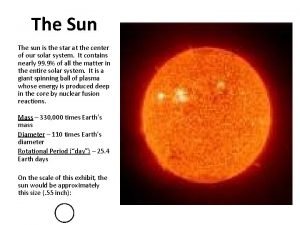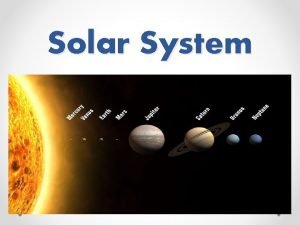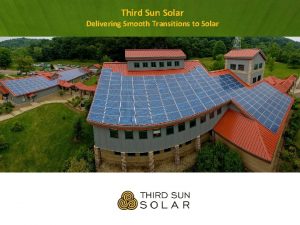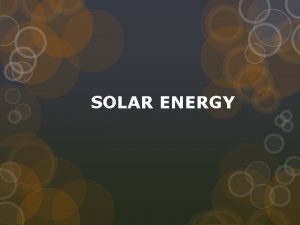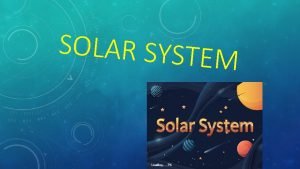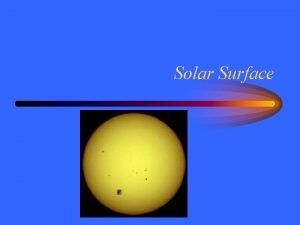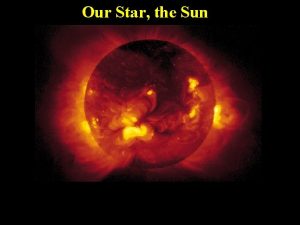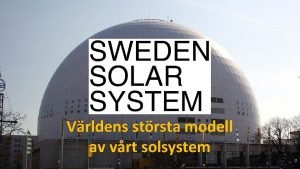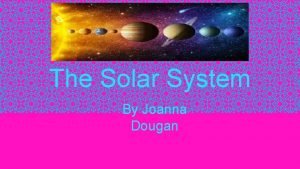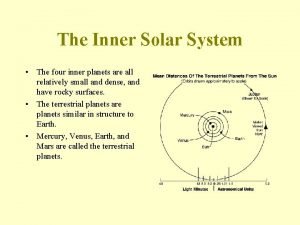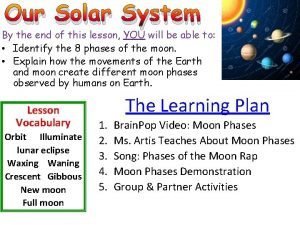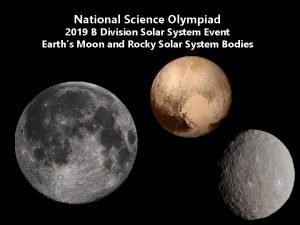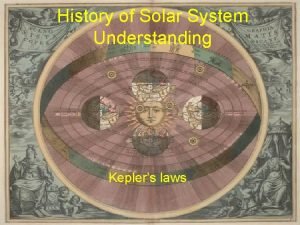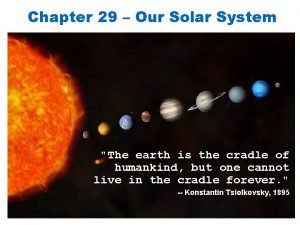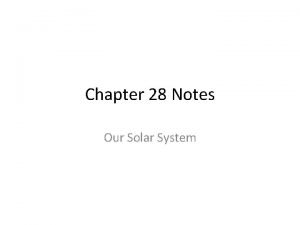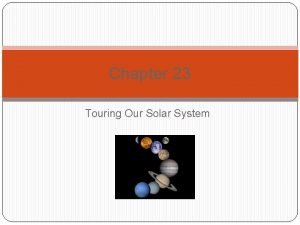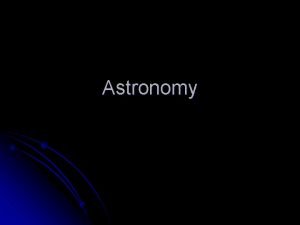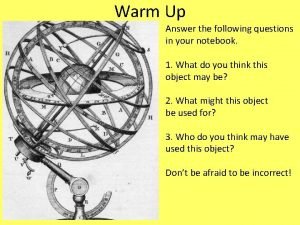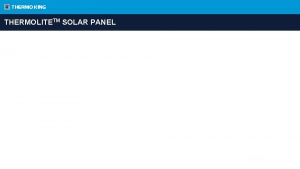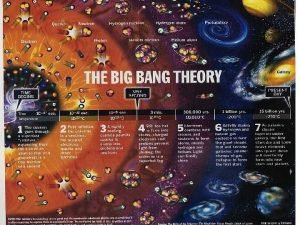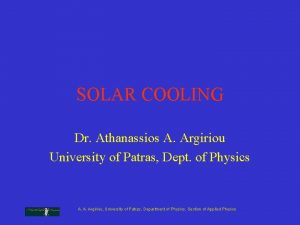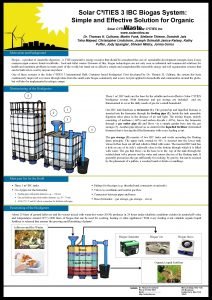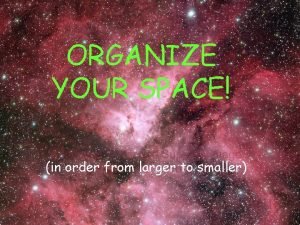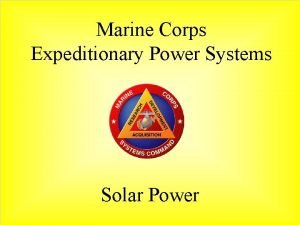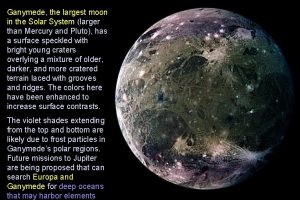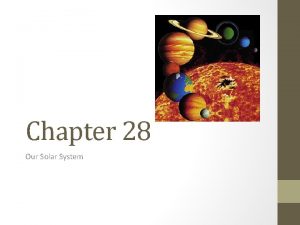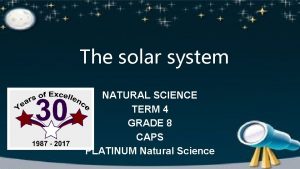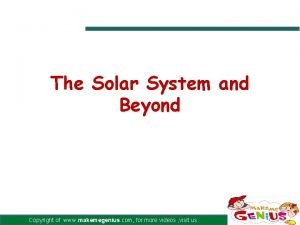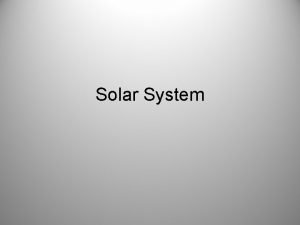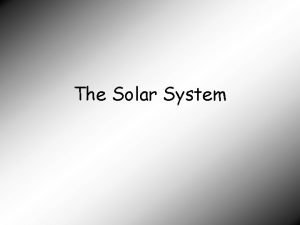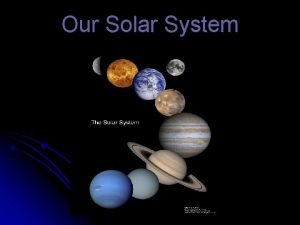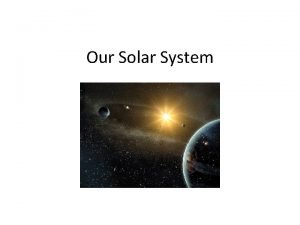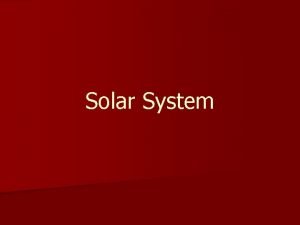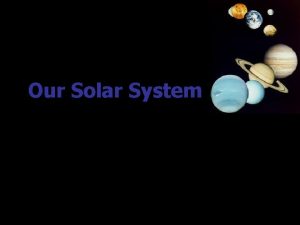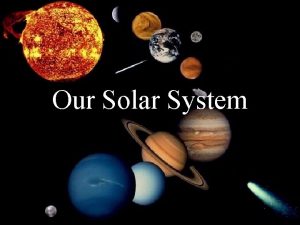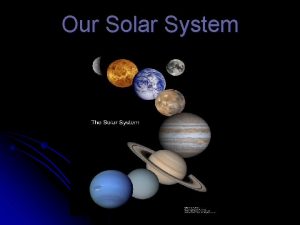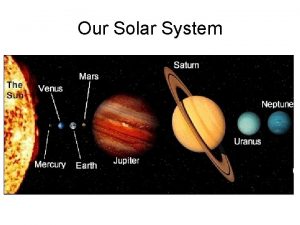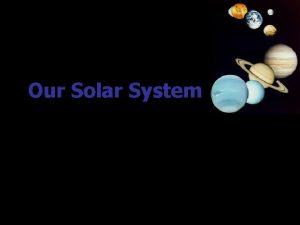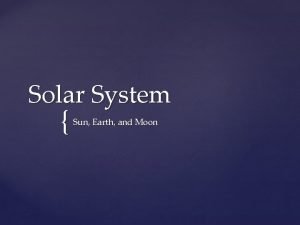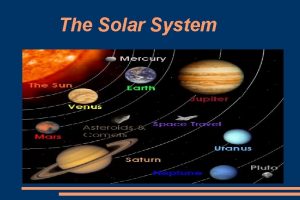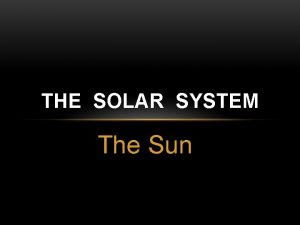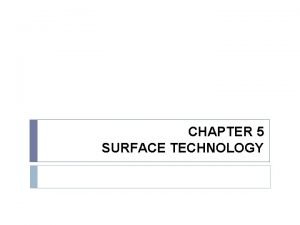THE SOLAR SYSTEM SUN SUN The surface of






































- Slides: 38

THE SOLAR SYSTEM

SUN


SUN The surface of the Sun is called the photosphere and is made up of thick gases. Photosphere is covered by two layers of atmosphere called the chromosphere and corona. Chromosphere is made up of hot gases (mainly hydrogen), that swirl around the surface of the sun. Within these gases storms can occur and even hurricanes. Corona is the outermost layer of the Sun and stretches towards the planets as far as Mercury, getting thinner all the time. Under the photosphere is the interior, made up of three hot layers: Core is where the light we see is created by nuclear reactions between hydrogen and helium.

SUN Radiative zone where the heat created in the core moves outward through the gases. Convective zone is where the energy is transported by convection. Convection is therefore allows the photosphere to be heated up by the interior so that we can see the light from the Sunspots appear as dark spots on the surface of the Sun. Temperatures in the dark centers of sunspots drop to about 3, 427 degrees Celsius (compared to the 5, 427 degrees Celsius for the surrounding photosphere). Sunspots usually last for several days, although very large ones may live for several weeks.

THE PLANETS TERRESTRIAL PLANETS

MERCURY

MERCURY CHARACTERISTICS Mercury has a very elliptical (oval-shaped) orbit. At perihelion (at its closest point) it is about 46 million km (28. 58 million miles) from the Sun, but at aphelion (at its farthest point) it is 70 million km away. It has a large iron core which is at least partially molten and generates a magnetic field about 1% as strong as that of the Earth’s. The surface consists of cratered terrain and smooth plains and many deep craters similar to those on the moon. Mercury is a planet of extreme variations. Dry, extremely hot and almost airless.

VENUS

VENUS CHARACTERISTICS Venus is regarded as the Earth’ sister planet. In some ways they are very similar: Venus is only slightly smaller than Earth (95% of Earth’s diameter, 80% of Earth’s mass). Both have few craters indicating relatively young surfaces. Their densities and chemical compositions are similar. It is also known as the morning star because at sunrise it appears in the east and evening star it appears at sunset when it is in the west.

VENUS CHARACTERISTICS Transit of Venus is the black silhouette of Planet Venus crossing the Sun’s face. It appears as a black disk 1/32 as wide as the Sun itself. The Transit of Venus occurs at intervals of 8 years, 121. 5 years, 8 years and 105. 5 years. Occurs in pairs (two times- eight years apart) and then followed by a gap of over 1000 years. The next Transit of Venus will occur on June 6 th 2012. The following transit will occur in December 11 th 2117.

EARTH

EARTH CHARACTERISTICS Earth is the largest of the terrestrial planets in the Solar system in diameter, mass and density. It is also referred to as the World and Terra. The only space in the universe where life is known to exist. The shape of the Earth is very close to that of an oblate spheroid, a sphere squished along the orientation from pole to pole such that there is a bulge around the equator.

EARTH CHARACTERISTICS It is composed mostly of iron (32. 1%), oxygen (30. 1%), silicon (15. 1%), magnesium (13. 9%), sulfur (2. 9%), nickel (1. 8%), calcium (1. 5%), and aluminum (1. 4%) with the remaining 1. 2% consisting of trace amounts of other elements. The Earth’s terrain varies greatly from place to place. About 70. 8% of the surface is covered with water, with much of the continental shelf below sea level. The remaining 29. 2% not covered by water consists of mountains, deserts, plains, plateaus and other geomorphologies.

EARTH CHARACTERISTICS The atmospheric pressure on the surface of the Earth averages 101. 325 k Pa, with a scale height of about 8. 5 km. It is 78% nitrogen and 21% oxygen, with trace amounts of water vapor, carbon dioxide, and other gaseous molecules. The Earth can be subdivided into specific latitudinal belts of approximately homogenous climates. Ranging from the equator to the polar regions, these are the tropical (or equatorial), subtropical, temperate and polar climates. Because of the axial tilt of the Earth, the amount of sunlight reaching any given point on the surface varies over the course of the year. This results in seasonal change in climate.

MARS

MARS CHARACTERISTICS Valles Marineris on Mars is the largest canyon in the Solar system. At 4. 5 mi (7 km) deep and 2, 400 mi (3, 800 km) wide. Mars has a very thin atmosphere, mostly carbon dioxide, but dust storms can cover the whole planet for months at a time.

MARS CHARACTERISTICS The planet has two moons Deimos and Phobos. Olympus Mons, a 550 km wide volcano, is the largest volcano in the solar system and covers an area about the size of Arizona. Every two years or so the Sun, Earth, Mars line up. This is called the opposition. In 2003 Earth and Mars was really close.

THE PLANETS JOVIAN PLANETS

JUPITER

JUPITER CHARACTERISTICS The atmosphere of Jupiter consists of about 84% Hydrogen and about 15% helium with small amounts of acetylene, ammonia, ethane, methane, phosphine and water vapor. Jupiter also sports a Great Red Spot, noted in its atmosphere for 300 years or more. It is a gigantic storm swirling and rolling endlessly and causing chemical reactions to create the intense colors.

JUPITER CHARACTERISTICS Jupiter’s shape is that of an oblate spheroid. Jupiter has a faint planetary ring system composed of three main segments: an inner torus of particles known as the halo, a relatively bright main ring, and an outer “gossamer” ring. Jupiter’s rotation is the fastest of all the Solar System’s planets, completing a rotation on its axis in slightly less than ten hours.

SATURN

SATURN CHARACTERISTICS The planet Saturn is composed of hydrogen, with small proportions of helium and trace elements. Saturn has a prominent system or rings, consisting mostly of ice particles with a smaller amount of rocky debris and dust. Due to a combination of its lower density, rapid rotation, and fluid state, Saturn is an oblate spheroid; that is, it is flattened at the poles and bulges at the equator. The elliptical orbit of Saturn is inclined 2. 48 degrees relative to the orbital plane of the Earth.

URANUS

URANUS CHARACTERISTICS Uranus has a ring system, a magnetosphere, and numerous moons. Uranus’ axis of rotation lies on its side with respect to the plane of the Solar System, with an axial tilt of 97. 77 degrees. This gives its seasonal changes completely unlike those of the other major planets. Uranus’ blue color is the result of absorption of red light by methane in the upper atmosphere.

URANUS CHARACTERISTICS Uranus has bands of clouds that blow around rapidly. But they are extremely faint, visible only with radical image enhancement of the Voyager 2. Uranus’ magnetic field is odd in that it is not centered on the center of the planet and is tilted almost 60 degrees with respect to the axis of rotation. It is probably generated by motion at relatively shallow depths within Uranus.

NEPTUNE

NEPTUNE CHARACTERISTICS When it was discovered in 1846, Neptune became the most distant planet in the Solar System. The gravity of Neptune is only 17% stronger than Earth’s gravity. That’s actually the closest to Earth’s gravity in the solar system. The core of Neptune is composed of iron, nickel and silicates, with an interior model giving a mass of about 1. 2 times more than that of the Earth. Neptune’s atmosphere is sub-divided into two-main regions; the lower troposphere, where temperature decreases with altitude and the stratosphere where the temperature increases with altitude.

ASTEROIDS

ASTEROIDS Celestial bodies of various sizes that move in orbits primarily between the orbits of Mars and Jupiter. SPECTRAL CLASSIFICATION of ASTEROIDS Classified into broad categories according to their brightness and color (technically their spectra).

ASTEROIDS Carbonaceous or C-type Asteroids More than 75 percent of asteroids fall into this category. With brightness of 0. 03 to 0. 09, these objects are very dark. Silacaceous or S-types Asteroids Approximately 17 percent of known asteroids are S-type. They have brightness ranging from 0. 10 to 0. 22. Metallic or M-type Asteroids These mid-region main belt objects are relatively bright, with brightness ranging from 0. 10 to 0. 18. M type asteroids are composed of metallic iron, like the iron meteorites.

KUIPER BELT

KUIPER BELT A region of space along the ecliptic outside the orbit of Neptune. It contains countless comets and super comets. It existence was predicted by Gerald Kuiper. It is similar to the asteroid belt, although it is far larger – 20 times as wide as and 20 -200 times as massive.

KUIPER BELT But while the asteroid belt is composed primarily of rock and metal, Kuiper belt objects are composed of largely frozen (dubbed ices) such as methane, ammonia and water. Since its discovery in 1992, the number of known Kuiper belt objects (KBOs) has increased over a thousand, and more than 70, ooo KBOs are over 100 km in diameter are believed to reside here.

OORT CLOUD

OORT CLOUD Proposed by Dutch astronomer Jan Oort in 1950. The Oort Cloud cannot be seen but almost certainly exists. It marks the edge of our solar system. A spherical shell of dormant comets, it lies between half and one light year from the Sun, at its limits of its gravitational grasp. Oort proposed it to explain why so many longperiod comets reach their greatest distance from the Sun in this region of space.

OORT CLOUD The cloud may contain trillions of comet nuclei, which falls towards the inner solar system only when disturbed by, for instance, a collision or the gravitational tug of a passing star. The Oort Cloud comets are thought to have formed closer to the Sun, and been ejected into the cold wastes of space by encounters with the giant planets shortly after their creation.
 The sun is the star at the center of the solar system
The sun is the star at the center of the solar system Dual sun solar system
Dual sun solar system Whole sale solar
Whole sale solar Inexhaustible source of energy
Inexhaustible source of energy Assurant springfield oh
Assurant springfield oh Solar energy is radiant light and heat from the sun
Solar energy is radiant light and heat from the sun Star sun solar
Star sun solar Triangular prism lateral surface area formula
Triangular prism lateral surface area formula High surface tension vs low surface tension
High surface tension vs low surface tension Curved surface area and total surface area of cone
Curved surface area and total surface area of cone Surface sun systems
Surface sun systems At the center of the sun, fusion converts hydrogen into
At the center of the sun, fusion converts hydrogen into Solar system webquest answer
Solar system webquest answer Sweden solar system
Sweden solar system Formation of the solar system comic strip
Formation of the solar system comic strip The four inner planets
The four inner planets Outer solar system brainpop answers
Outer solar system brainpop answers Science olympiad solar system
Science olympiad solar system Kepler's model of the solar system
Kepler's model of the solar system Www.makemegenius.com solar system
Www.makemegenius.com solar system Chapter 29 our solar system
Chapter 29 our solar system Chapter 28 our solar system
Chapter 28 our solar system Chapter 23 touring our solar system
Chapter 23 touring our solar system Kepler's model of the solar system
Kepler's model of the solar system Where is the solar system located in the milky way
Where is the solar system located in the milky way Solar panel table
Solar panel table What are terrestrial planets made of
What are terrestrial planets made of My very excited mother just served us nachos
My very excited mother just served us nachos Big bang solar system
Big bang solar system What separates the inner and outer planets?
What separates the inner and outer planets? Solar cooling system
Solar cooling system Biogas ibc container
Biogas ibc container What is each planet made of
What is each planet made of The solar system in order
The solar system in order Pv&e
Pv&e Ganymede moon
Ganymede moon Chapter 28 our solar system
Chapter 28 our solar system Grade 8 natural science solar system
Grade 8 natural science solar system Www.makemegenius.com solar system
Www.makemegenius.com solar system
